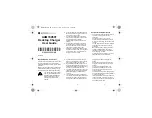
Page 7 of 8
Unit 2, 110 Station Road, Seven Hills ,NSW, 2147, Australia
1700W Solar Battery Charger
Maximum Power Point Tracker
Operating Instructions
Please read these instructions before use
Model:
MPPT30-2L
Figure 5 (
Above
):
High Capacity Setting
Figure 6 (
Above
):
Long Life Setting
MPPT FAQs
Q: What is an MPPT?
MPPT stands for Maximum Power Point Tracker and is a specialized converter designed to maintain the PV
voltage at the level in which it delivers maximum power to the load or battery. The panel’s nominal output
power can only be obtained with the use of an MPPT.
Q: What are the MPPTs advantages compared to standard solar regulators?
1.
About 20% higher current in a typical application which can be used for higher loads or longer
run times or cutting PV system cost.
2.
Suitable for lower cost non battery type PV since the MPPT can efficiently charge the batteries
from relatively high voltage, say 12V batteries from 40V MPP panels.
3.
Less interference and more accurate voltages during saturation and maintenance.
Q: What happens at low PV currents?
The MPPT will outperform the conventional regulator above 3% of nominal panel power. Below 3%,
about 10W in a 400W panel, the MPPT will have a slightly lower output current than a non MPPT.
Q: Why are MPPT not more common in standalone solar systems?
Until now and despite their overwhelming advantages MPPTs have not been commonly used in
standalone solar systems because of cost. The new GSL MPPT specifically addresses this issue
making economic sense in a wide range of solar systems.
MPPT30-2L-R3


























